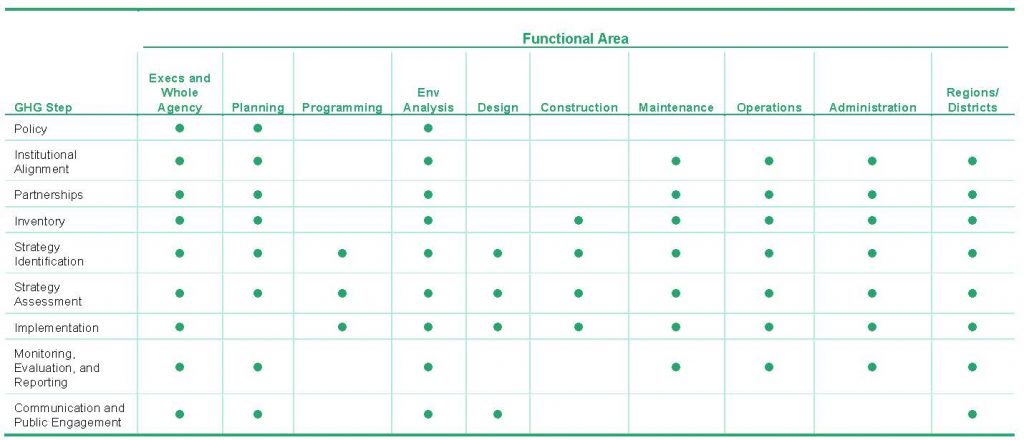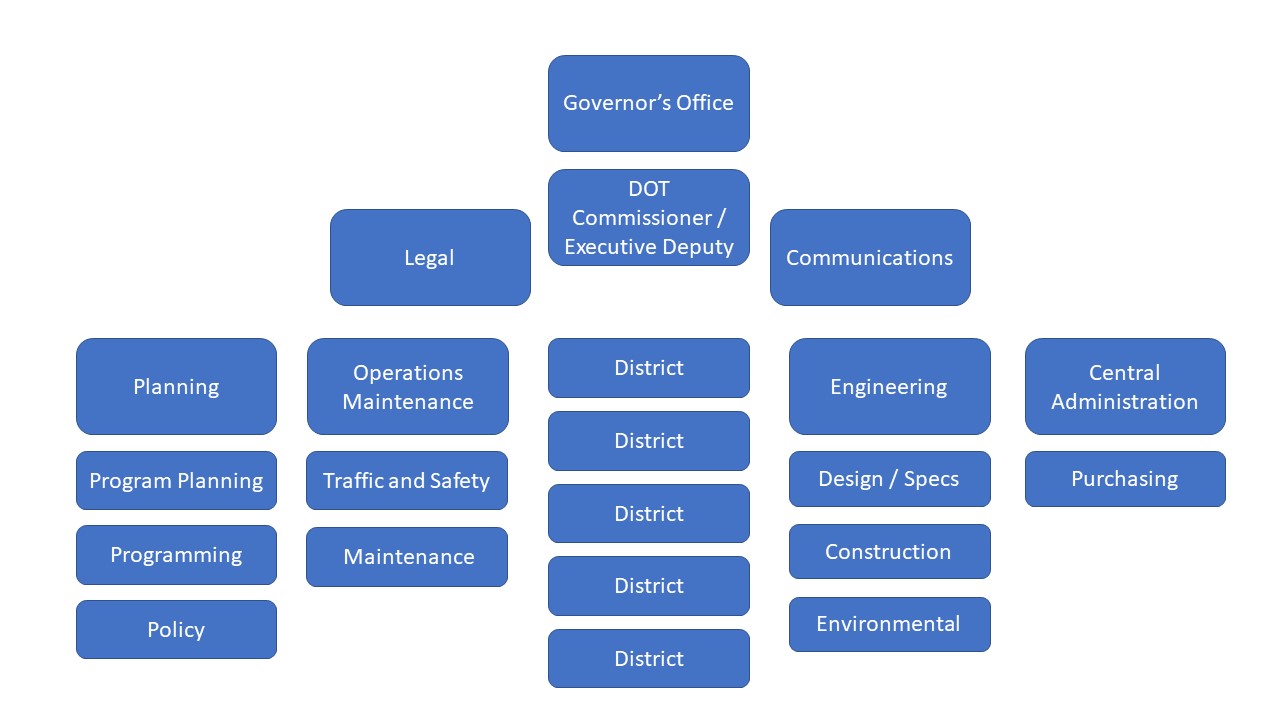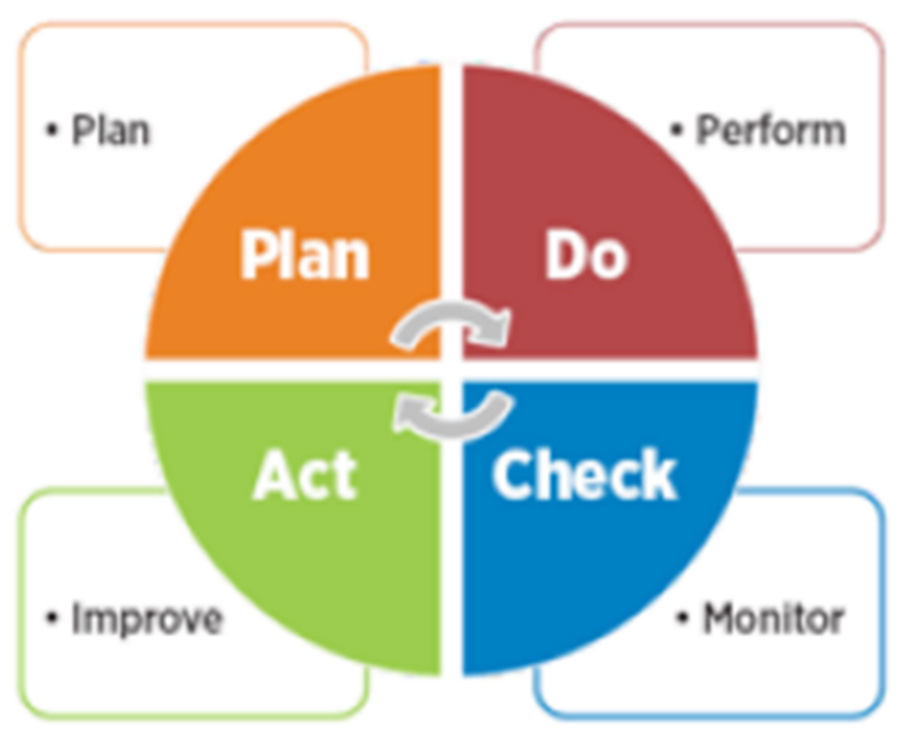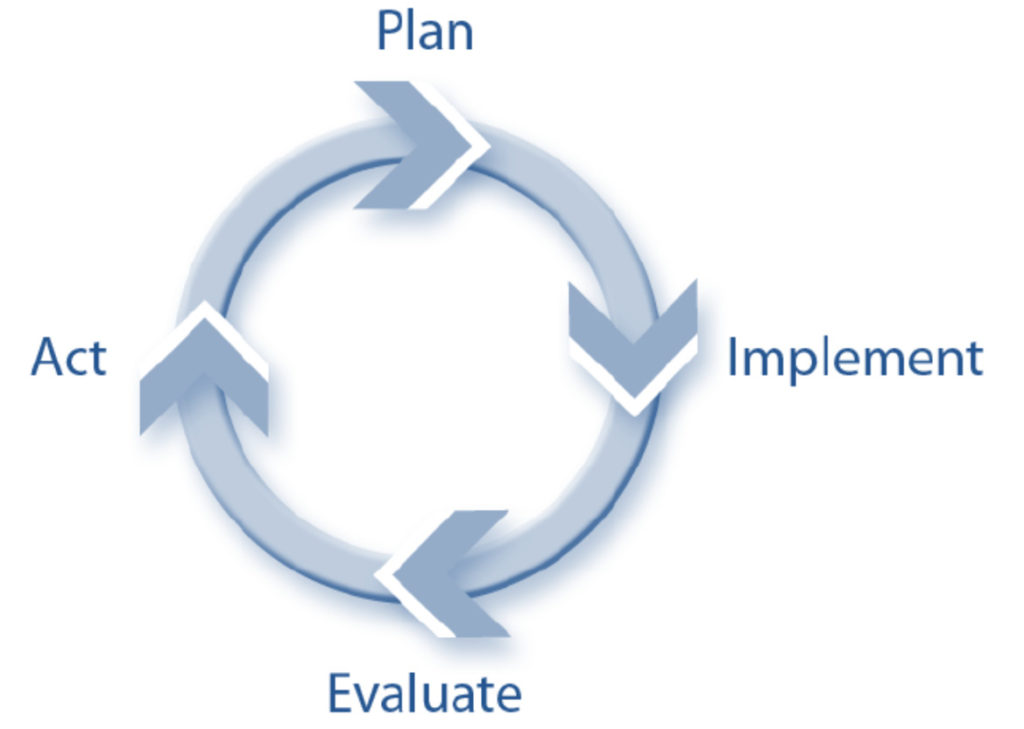19.0 Putting It All Together
- 19.1 What Is Included?
- 19.2 Why Address GHGs Holistically?
- 19.3 Level of Effort
- 19.4 Complementarity/Consistency with Other Transportation Goals
- 19.5 Who—Roles and Responsibilities
- 19.6 Getting Started—GHG Scoping Considerations
- 19.7 Policy Development, Institutional Alignment, Partnering (Plan)
- 19.8 Inventory and Strategy Identification; Implementation; Monitoring, Evaluation, and Reporting; Communication and Public Engagement (Do)
- 19.9 Strategy Assessment (Check)
- 19.10 Act (Adjust, Improve)
- 19.11 Self-Assessment: Putting It All Together
19.1 What Is Included?
This section will discuss how departments of transportation (DOTs) can achieve greenhouse gas (GHG) emissions reductions within the organizational framework explained in Section 4.0 and summarized in Table 19.1. In this section, it is assumed that DOT executive management is supportive of reducing GHG emissions, if not leading the charge, and that other State agencies are on board.
With this general construct as a point of departure, it is still a given that all DOTs are unique to varying degrees. Even the individual units within a DOT have their own cultures, capacities, competing demands, and priorities that change over time. In addition to institutional vagaries, time is a factor. Significant GHG reductions will be the product of years of work involving a wide range of agency functions, which will also tend to evolve over time. Ideally, most GHG reduction efforts can be reasonably aligned with the department’s principal mission as the program matures. Within these caveats, the following general guidance is offered.
19.2 Why Address GHGs Holistically?
While application of the tools and resources in this guide might seem straightforward, as a program they involve organizational change. Organizational changes often fail because the day-to-day pressures of completing traditional tasks consume the time and energy required for institutions and people who have devoted decades to their traditional mission to deliver new and unfamiliar products. Real work is required to effect real change.
19.3 Level of Effort
The speed with which emission reductions can be achieved and the degree of effort required will depend upon several interdependent factors, including
- Current versus desired GHG engagement level—If an agency at Engagement Level 1 lacking any real history, capacity, or institutional motivation to reduce GHG emissions is suddenly asked to achieve documented significant reductions at Level 3, more effort will be required than if the agency already is deeply engaged and merely trying to “up its game” in a few program areas.
- Motivation—What’s the priority for success? Is it a priority across the entire organization? Are priorities likely to change? Do staff believe this is more than a “flavor of the month”? Does success involve achievement of quantitative goals or simply a public demonstration of earnest resolve?
- Capacity—What is the organization’s current level of engagement? Do the functional areas within the department possess the expertise and resources needed to fulfill their roles? Are funds available?
- Leadership—Are executives committed to success? Do they truly understand how to effect change? Are they prepared to devote the time, attention, and sacrifice needed to “turn the battleship”?
Table 19.1 DOT Functional Unit GHG Activities

19.4 Complementarity/Consistency with Other Transportation Goals
As discussed in the functional area sections, GHG reduction strategies are generally consistent with ongoing unit priorities such as safety, mobility, reduction of fuel and energy consumption, reduction of criteria pollutants and air toxics, and operational efficiencies. Whenever possible, these synergies should be repeatedly stressed and reinforced. As mentioned in Section 6.0, DOT functional units tend to be good at and take pride in what they do. GHG reductions can often be readily achieved by units encouraged to do more of “what they do.” It is less effective to “force feed” assignments to units that see the required efforts as something opposed to what they have “always done.”
19.5 Who—Roles and Responsibilities

As discussed in Section 6.0, roles and responsibilities will vary by engagement level. Each functional area has its own section of the guide providing more detail. To summarize:
- Executives—Send a clear signal that GHGs are to be considered and should shape programs and projects as one of many considerations. Encourage a life-cycle approach to costs and benefits. Support budget initiatives as needed to reduce emissions. Adjust staffing as needed. Be present! Lead!
- Administration/Purchasing—As appropriate, support agency efforts in purchasing and facilities to reduce GHG emissions through the use of renewable energy technologies. Innovate!
- Planning—Provide guidance, direction, tools and targets for reducing GHG emissions. Collaborate!
- Programming—Direct funding to projects and programs for GHG reduction. Engage!
- Environmental—Provide technical support to Regions/Districts and Central Office for the evaluation of reduction strategies. Educate staff on the need to reduce GHG emissions. Explain!
- Design/Specification Writer—Develop designs and specifications for GHG reduction. Support agency efforts to employ GHG-emission-reducing materials consistent with their needs. Promote the use of recycled materials and fly ash to replace concrete as practicable. Be diligent!
- Construction—Develop procedures that minimize the need for ongoing maintenance. Require lower GHG fuels, processes, and materials. Hold the line on exceptions and appeals. Be prepared to adjust methods and materials. Deliver!
- Maintenance—Provide procedural and technical support to Regions/Districts for implementation and evaluation of reduction strategies. Be prepared to adjust procedures and modernize fleets and facilities. Perform!
- Operations—Make GHG emission reduction a central metric for program success. Show how transportation systems management and operations (TSM&O) investments are the most cost-effective means of achieving major GHG improvements along with a wide range of associated mobility and safety benefits. Go!
- Regions/Districts—Reduce GHG emissions in accordance with agency policy. Provide feedback to Central Office units. Deliver results on the ground. Encourage and educate local agencies and constituencies. Show how it is done!
19.6 Getting Started—GHG Scoping Considerations
To “put it all together,” i.e., harness the administrative power of a DOT to reduce GHG emissions, it is important to understand how the machinery works. To a greater or lesser degree, virtually all DOTs use some form of “matrix management” wherein individual program units in the Central Office assist and guide Region/District units. Figure 19.1 shows a typical organizational chart.
Figure 19.1 Simplified Generic DOT Organizational Chart

Figure 19.2 and Figure 19.3, two variations of the “quality cycle,” illustrate the basic approach most DOTs use in addressing an ever-changing set of priorities and conditions. This basic approach has many names (and comes in many flavors)—including Performance Management, ISO, Six Sigma, Balanced Scorecard, Baldrige, Total Quality Management, etc.—but at the end of the day, virtually all DOTs operate within some “continuous improvement” system. And if GHG mitigation is to prosper within the DOT management system, it should use the system.
Figure 19.2 Plan-Do-Check-Act Cycle

Source: American Society for Quality, Figure 1: Plan-do-check-act cycle, https://asq.org/quality-resources/pdca-cycle.
Figure 19.3 Plan-Implement-Evaluate-Act Cycle

Table 19.2 illustrates how “the system” may be applied in terms of GHG emission particulars.
Table 19.2 GHG Management Cycle: Internal Agency
| Plan | Set policy | Establish targets | Make assignments |
| Do | Develop procedures | Train staff | Implement |
| Check | Report | Consolidate reports | Evaluate performance |
| Act (Improve) | Check in with partners | Explore alternatives | Revise procedures |
Source: Adapted from Using an Environmental Management System to Meet Transportation Challenges and Opportunities: An Implementation Guide (AASHTO, 2003) and Beyond the Short-Term—Transportation Asset Management for Long-Term Sustainability, Accountability and Performance (FHWA, 2010b).
19.7 Policy Development, Institutional Alignment, Partnering (Plan)
A good starting place for any initiative is to benchmark where you are and define where you want to be. In the DOT world, “where you want to be” typically comes in the form of an assignment (“get this done”), with the “where are we” and “how do we proceed” to be determined. From this beginning, the material provided in this guide may be used to locate the agency on the spectrum of GHG engagement and inform the development of an interim GHG policy (Section 5.0) in light of institutional considerations (Section 6.0) and any initial specified partnering arrangements (Section 7.0). The functional unit, management, and communications materials—and especially the GHG self-assessment tools included in each of these sections—have been provided to assist in this.
With the results of these initial efforts as a guide, the agency’s GHG effort may be structured in keeping with “the usual” agency model for long-term, overarching initiatives involving disparate functional units. Most commonly, these efforts should be formally initiated through the issuance of an “executive charter” that explicitly defines roles, responsibilities, and expectations—thus providing an explicit set of rules for engineering-minded managers to use in addressing issues and opportunities as they arise over the long term.
A model charter to “mitigate GHG emissions” per AASHTO examples is shown directly following this paragraph (see “XDOT GHG Task Force Charter”). Charters may be drafted by an executive, by staff, or by the task force itself. They should be taken very seriously, carefully vetted before issuance, and periodically revisited in a systematic manner. With agency intentions clarified, individual program units may be asked to familiarize themselves with possible roles and responsibilities as detailed in their unit sections of the guide. As appropriate, each should also be required to perform an individual self-assessment and asked to develop an initial list of potential deliverables for discussion at a kickoff meeting. A model agenda for a GHG task force kickoff (“XDOT Model GHG Task Force Kickoff Meeting Agenda”) is provided following the model charter.
XDOT GHG Task Force Charter
Date: December XX, 202X
Purpose: The GHG Mitigation Task Force shall investigate, assess, report on, and implement GHG emission reduction measures for all direct and indirect DOT-related GHG emissions, including
- Transportation System Users.
- Agency Construction and Maintenance Activities.
- Agency Facilities.
Membership: The GHG Task Force will be composed of the Division Directors of each DOT Division, who may each designate one or more task force representatives. Bureau Directors shall also be members as designated by the Task Force Chair. Other individuals to be included on an exception basis.
Structure and Governance:
- Executive Sponsor—Executive Deputy Commissioner for Planning.
- Chair—Planning Division Director.
- Staff—Planning Division, Environmental Bureau, others TBD. Time to be charged to PIN XYZ.
The Task Force Chair shall direct and preside under the guidance and sponsorship of the Executive Sponsor. The Task Force will be responsive to internal and external stakeholders and advance GHG reductions through research, experimentation, and implementation in keeping with the economic, social, and environmental needs of our state.
Meetings: The Task Force is expected to meet on a monthly basis as scheduled by the chair. Particular subgroups may also meet on a regular basis as needed. Quarterly review sessions are to be held with the Executive Sponsor.
Reporting: The Task Force Chair will formally report on progress to the Executive Sponsor on a quarterly basis and address issues to the Executive staff at the Commissioner’s staff meeting on an as-needed basis. Task Force progress will also be included as an item in the Planning Director’s monthly report to the Executive Deputy.
Deliverables:
- Strategic Plan—Within 3 months, the Task Force will develop an initial strategic plan describing how the Agency will advance its GHG mitigation efforts over the next 3 years in general consistency with the NCHRP Project 25-56 guidance for moving from Engagement Level 2 to Level 3.
- Assignment Matrix—Within 6 months, the Task Force will develop an initial list of “Who/What/When/How” assignments for Task Force Members for approval by the Executive Sponsor. These assignments will be based on self-assessments provided with this guide and include those actions needed to draft and implement early action items for the Strategic Plan.
- Annual Report—At the end of Year 1, the Task Force shall make a formal report on its progress and suggest amendments to this charter if there are any. Other amendments may be suggested to the Executive Sponsor for formal consideration as needed.
Signed,
Commissioner XDOTSource: Based on AASHTO examples, transportation.org/home/organization/aashto-committee-and-council-charters/.
XDOT
Model GHG Task Force Kickoff Meeting Agenda
1—Introductions/orientation—(Executive Sponsor)
2—GHG executive charter—(Task Force Chair)
3—Interim GHG policy—(Agency Policy Director)
4—Discussion (All)
5—Unit by unit reaction (Unit Heads)
6—Initial assignments (Task Force Chair)
7—Unit self-assessments (Task Force Staff)
8—Housekeeping—way forward, record keeping, interim standard agenda, next meeting (Task Force Chair)
9—Concluding remarks (Executive Sponsor)
19.8 Inventory and Strategy Identification; Implementation; Monitoring, Evaluation, and Reporting; Communication and Public Engagement (Do)
With everyone on the same page per the executive charter, initial meeting, and guide assessments, individual program unit assignments can be explained, negotiated, documented, and adjusted as work proceeds. If at all possible, “early wins” should be encouraged, achieved, and celebrated. To minimize the inevitable miscommunications, misunderstandings, mistakes, and errors, it is strongly recommended that GHG task force assignments be explicitly recorded in tabular format (Who, What, When, How) and subsequently shared, vetted, and acknowledged in the normal course of business. The current status of each individual assignment should be openly revisited, reviewed, updated, and confirmed as a standing agenda item. A model “standing agenda” is shown in “XDOT Model GHG Task Force Standing Agenda.”
XDOT Model GHG Task Force Standing Agenda
1—Opening remarks—(Executive Sponsor)
2—New developments—(Task Force Chair)
3—GHG policy changes—(Agency Policy Director)
4—Unit reports (Unit Reps.)
5—GHG task force progress/reporting (Task Force Chair)
6—Unit assignment updates (Task Force Staff)
7—Open discussion
8—Next meeting (Task Force Chair)
9—Concluding remarks (Executive Sponsor)
19.9 Strategy Assessment (Check)
With assigned efforts underway, the real issues and problems attendant to any initiative should manifest themselves as work proceeds. To address the inevitable glitches, it is essential that they be identified rather than hidden. This is why task force meetings should be held on a systematic and frequent basis as work progresses. Experience has shown that staff are naturally reluctant to admit a failure to accomplish something, but if asked directly, staff will usually “fess up” if some clearly defined milestone has been, or is likely to be, missed. Identification of a developing problem is the first essential step in addressing the issue. With the problem identified, help can be provided, or plans can be modified—the earlier the better.
As stipulated in the executive charter, GHG task force progress should be defined in terms of actions taken versus actions proposed for each program area for internal monitoring and strategy evaluation. For example, a reduction in embedded emissions from concrete through a change in specifications on the incorporation of fly ash by the materials unit could be tracked and reviewed at every meeting until it is complete. Reporting on emissions avoided will tell the tale of agency GHG success to outside stakeholders.
19.10 Act (Adjust, Improve)
With problems identified and solutions initiated, implementation along the revised path continues. Problems will continue to crop up but, with time and persistence, these too will be identified, addressed, and solved as the “Plan, Do, Check, Act (Improve)” cycle progresses meeting by meeting.
Tools for assessing GHG engagement at the structural level, including a DOT functional unit GHG benchmarking worksheet, may be found in the following subsection. Additional tools are contained in each of the functional area sections. The functional area self-assessment materials are designed for unit-based application, and a more agency-focused assessment may be found in Section 6.0. That section also contains additional guidance on “who can do what” to achieve GHG reduction in DOTs and is intended for consideration in organizing (and reorganizing) agency efforts.
19.11 Self-Assessment: Putting It All Together
A self-assessment worksheet is provided to assist State DOT staff, especially in the Executive functional area (but also others with responsibility for leading GHG initiatives), in determining where their agency falls on the GHG engagement spectrum and what additional actions they may wish to take to measure and reduce GHG emissions.
Click to download – Self-Assessment: 19.0 Putting It All Together
In addition to the self-assessment worksheet, a DOT functional unit GHG benchmarking worksheet is provided. For each of the cells, indicate actual versus desired (actual/desired) involvement by each of your functional areas in each of the relevant GHG steps—as appropriate for your agency, using a 1 to 4 scale.
Blank cells suggest limited involvement per material presented in the institutional alignment and unit functional area sections of this guide. Reference to these sections is encouraged as step 1 of this benchmarking exercise. Low actual versus desired value entries may suggest gaps worthy of further internal discussion as your agency strives to “put it all together” based on this “granular” picture of where you are versus where you want to be.
Click here to download the functional unit GHG benchmarking worksheet.